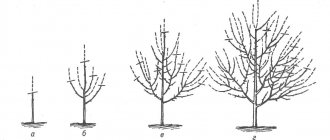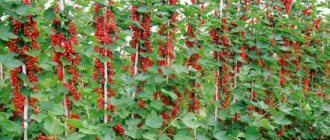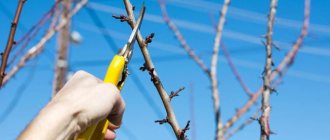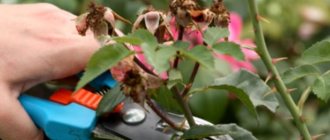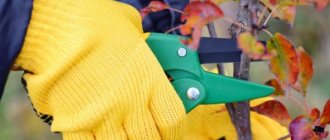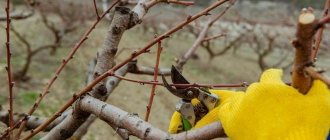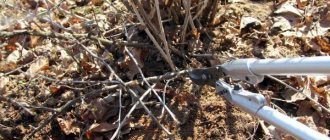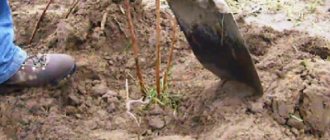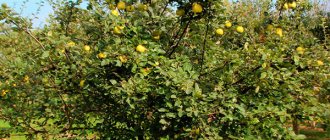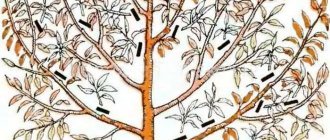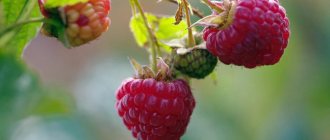When should you prune raspberries in the fall, in what month?
Pruning in the fall is necessary to increase the winter hardiness of the shrub and prevent the development of fungal infections.
Also, after the procedure, the raspberry plant does not look neglected, and it becomes convenient to work with.
The procedure is carried out from the first days of September until November. This variation is associated with the climatic characteristics of different Russian regions.
If averaged, this is the period from mid-September to the second decade of October, or about a month before the first morning frost.
In general, experienced summer residents advise pruning
How does autumn pruning differ in different regions?
The differences in pruning are related to the climate; it is he who makes adjustments to its technique:
- In the central regions of the Russian Federation and in the Moscow region in particular, young shoots do not need to be pruned for the winter. It is enough to tie them and cover them. This method allows you to use snow as a natural insulation. But the use of artificial covering materials can be harmful - condensation often forms under it, which provokes the development of fungal diseases.
- In Siberia, autumn pruning is a mandatory agrotechnical activity. The winters here are so cold that you can’t do without shelters, and pruned bushes make it quick and easy to cover your raspberry patch.
- In the Krasnodar Territory, pruning is carried out in late autumn. Gardeners have time to get another autumn harvest. True, autumn raspberries are small and there are very few of them, but it’s still nice when the bushes continue to bear fruit at such a late time.
Raspberries are unpretentious and bear fruit under any conditions, but if you are interested in a good harvest, in large and sugary berries, then do not be lazy to trim the raspberries on time. You should pay special attention to autumn pruning - it is important to correctly calculate the timing and follow the technique of this important agricultural activity.
0
0
Copy link
Timing for autumn pruning of raspberries depending on the region
When exactly to prune a bush is largely decided depending on weather and climatic conditions.
The table below shows the approximate timing of the procedure in various Russian regions.
| Region | When is the best time to prune bushes? |
| South | From the second ten days of October to the first ten days of November |
| Central Black Earth Region | First half of September |
| central Russia | First days of September |
| Leningrad region | End of August - beginning of September |
| Volga region | First half of September |
| Ural | End of August - beginning of September |
| Siberia | End of August - beginning of September |
| Far East | End of August - beginning of September |
Common Beginner Mistakes
Beginner gardeners feel sorry for cutting out branches. It seems that the more there are, the better. Other mistakes are also made.
- They leave a lot of shoots in the hope of getting a big harvest. In fact, thickening leads to disease and reduces yield. Normally, you need 5-10 raspberry branches, depending on the variety and method of cultivation.
- They leave branches intersecting or rubbing against each other. Abrasion of the bark leads to fungal and bacterial infection.
- Inappropriate pruning patterns are used.
- Leave the stumps - you need to cut the raspberry shoots at the root.
- They damage the kidneys. This problem happens when you are careless. First you need to cut out the older, larger shoots, then the smaller ones.
Another common mistake is using a bad tool. Many gardeners have one pruner for all occasions; they use it to prune the apple tree and fight the growths. Such a tool lies anywhere, becomes dull, and jagged edges appear on the blades. As a result, instead of an even cut, lacerated wounds form on the shoots, which heal poorly and become a haven for various bacteria.
The tool for pruning garden raspberries must be sharp, and it is advisable to disinfect the blades before work; you can simply wipe them with alcohol.
How to choose the right time to prune raspberries according to the lunar calendar in 2021
Many experienced summer residents and gardeners focus not only on the regional climate and weather in the fall, but also on the lunar calendar.
According to the biodynamic method of plant growing, raspberries need to be pruned during the waning moon. Since it is during this lunar phase that juices and mineral elements move from the tops of the shoots to the base, i.e., to the roots.
Of course, it is not always possible to plan the work so as to get to the “correct” phase of the moon. In this case, it is allowed to work on the growing crescent.
The main thing is not to work on the days of the full moon and new moon.
Favorable days to prune raspberries in the fall in 2020
In accordance with the principle outlined above, good days for pruning raspberries in 2021 will be:
- In September – 3 – 16.
- In October – 3 – 15.
- In November – 1 – 14.
Unfavorable days
Bad time for the procedure:
- In September – 2, 17.
- In October – 2, 16, 31.
- In November – 15, 30.
How to properly prune raspberries for the winter
Why prune raspberries at all? There are several reasons for pruning that are worth knowing:
- The main rule that is worth remembering is that either green mass or berries predominate on the plant.
- In addition, if the plant is allowed to thicken, it will immediately negatively affect the health of the bushes. Dense thickets are a dream for parasitic insects and various diseases.
- The consequences will affect future harvests, the size and quality of the berries. The berries may shrink and become sour.
In spring, healthy pruning of the bush is necessary, when dry and damaged shoots are removed. Autumn pruning has a number of reasons:
- By renewing the bushes and removing old shoots, we ensure a good harvest. Will explain. The fact is that a one-year-old shoot does not produce a harvest at all. Only a two-year-old tree begins to bloom and, accordingly, bear fruit. It is in the 2nd year that the harvests are especially rich. By the third year there are fewer berries on the bush and they themselves are small. Conclusion: the bush should consist of one-year and two-year shoots.
- Pruning is important to remove diseased branches or overgrowth. If the bush is left as it is, autumn-spring moisture can cause much more harm in the form of diseases.
- The bush needs light and fertilizing. If the bush has thickened, then both the first and second factors will clearly not be enough for all the shoots. This means the plant will suffer.
But this does not mean that you can somehow trim the plant. Incorrect pruning will also cause damage to the crop!
It is better to form a bush for next year during the waning moon, when it is in the 3rd or 4th phase.
Basic rules for pruning:
- The most important thing in preparing raspberries for winter is that the shoots should never be broken off or pulled, even if they appear completely dry. They need to be cut off with sharp pruning shears.
- Dry, diseased and weak branches are cut off at the root. After forming the bush, they need to be burned, but under no circumstances should they be left near the bush.
- The branches that had berries this year are cut off. As a rule, these shoots can be identified by their brown color at the base.
- After autumn pruning, 6 to 8 shoots should remain in the bush. In the spring, the bush is checked; if any branches are missing or frozen, they should be cut off, leaving 5 healthy shoots.
- Raspberries on a trellis are pruned so as to maintain a distance of 10-15 cm between shoots.
- After pruning, the bush should be dug up. Add fertilizer to the soil and treat the shoots with copper sulfate.
The most common advice from gardeners is that after pruning the bush needs to be tied up, fixing each shoot to a support. If the winter is windy, the branches will not be damaged. And in severe frosts, such a bush can be insulated.
And further. It is very important which tool is used for pruning. There are 2 main requirements for pruning shears:
- The tool must be sharp to ensure an even cut. A dull tool will make an uneven cut or even crumble the stem. Moisture will get into the cracks, and severe frost can destroy the shoot.
- Both diseased and healthy shoots are pruned. In order not to transfer diseases from one raspberry branch to another, you need to disinfect the tool.
It's not difficult to follow the rules. But the reward for this is a healthy plant!
How to properly prune raspberries in the fall, features
Now let's talk about the features and principles of autumn pruning of raspberries.
Let's look at what equipment is needed, what methods are best to use, and what is the correct height for pruning raspberries.
What is needed for the procedure
A high-quality instrument is the key to a successful and quick procedure.
The raspberry tree also needs to be freed from fallen leaves, grass and mulch (if there was any).
Be sure to decide on a cutting plan in advance. To do this, examine the raspberry plant and figure out which method is better. Maybe even draw a diagram.
Required Tools
For high-quality pruning of raspberries, you need a good sharpened tool. A pruner or lopper with long handles will do. To protect your hands from scratches from thorns, wear gloves.
ON A NOTE. Secateurs can be easily replaced with garden shears. The main thing is that they are sharp.
What rules for pruning raspberries should be followed?
For an experienced gardener, there are no secrets or difficulties in trimming raspberries. But a beginner needs to learn the basic rules of this procedure.
First of all, two-year-old shoots are cut down to the ground. Then the weakest and most damaged annual stems are removed.
All cuts must be made carefully with a sharp tool so as not to damage the remaining part of the raspberry.
Next, we shorten the tops of the annual shoots. You need to cut a little more than 20 cm. There should be no more than 6 annual stems per plant. This is the optimal number of shoots for fruiting. In this case, the plantings will not be thickened.
Another rule that is often forgotten. If cut branches show signs of infection or disease, they should be burned. This way you will destroy pathogenic organisms. And in general, it is better not to leave cut stems in the raspberry garden.
Also be sure to remove fallen leaves and sawdust. All this is burned, and the ashes are then used as fertilizer.
What pruning methods are there?
There are 2 basic principles for pruning raspberries: full and partial. Full involves filing the stems almost to the very root. With partial, a few of the strongest and healthiest branches are left.
They will bear fruit next year.
All raspberry thinning schemes used use one of these two principles.
How high should you trim raspberries?
Raspberry stems that are designated for full pruning should be removed at the root. A maximum of 5 cm can be left. This eliminates the possibility of infection or the appearance of parasites.
Basic Rules
Autumn pruning combines the removal of infected, damaged and dry shoots with the complete elimination of shoots. The event is carried out in compliance with several technical rules, the same for any variety of raspberries.
Technique
When pruning in autumn, it is important to follow these rules:
- To avoid thickening of plantings and excessive foliage, pruning is planned so that the branches do not overlap each other, but are arranged in a fan.
- First, all two-year-old shoots are removed. This is done immediately after harvesting. And they cut them off to the very root.
- Broken and damaged branches are also removed to the very roots, not even leaving stumps. Damaged branches, if left, will take a lot of energy from the plant, and the berries will still grow small and tasteless.
- Whether to remove annual shoots or not depends on the climate. During warm winters, they can be left tied in bunches so that the wind does not fray. In regions with harsh winters, young growth is pruned and plantings are covered. Young shoots, not having time to become woody, often freeze and die.
- Shoots that grew in the middle of summer are removed - they are too weak to survive the frost.
At what height is the pruning done?
How to determine the cutting height:
- The tops of young shoots are trimmed so that the height of the shoots is 1.2-1.5 m.
- If young shoots are poorly developed, they can be pruned to 1 m.
- Weak tops are cut off to the first healthy bud.
- Approximately 25 cm is removed from each branch.
The result will be a planting in which all bushes will have equal height.
Schemes for pruning raspberries in autumn with pictures, step-by-step instructions
There are several approaches to sawing raspberries in the fall. Below are step-by-step instructions and visual diagrams for carrying out this agricultural activity.
Classic method
This is the usual way of carrying out the procedure: we cut out weak, diseased branches, cut off two-year-old stems at the root and pinch the tops of annual ones.
How to prune remontant raspberries
These varieties of crops can be sawed off in the classical way, or they can be cut completely to the ground.
Typically, partial pruning is recommended for gardeners and summer residents in cold regions of our country. But in the Crimea, Kuban and the Caucasus, shrubs can be sawed down to the ground.
Pruning remontant raspberries for one harvest
Some summer residents find it more convenient to harvest berries at the very end of the summer season. But so that there are a lot of raspberries.
For this purpose, such pruning is carried out. After the first autumn frosts, all stems are cut at the root.
It is very important to wait until the first frost so that the cut stems do not grow back.
In the spring it will be necessary to thin out the stems, leaving a few of the strongest ones.
How to prune remontant raspberries for two harvests
With this method, the procedure is carried out as follows. After picking berries in the summer, the fruit-bearing branches are cut out at the root.
In mid-autumn, after the second wave, the tops are pruned.
Exact terms and conditions of pruning
Autumn is considered the best time to prune raspberries. The main thing is not to postpone this event until frost. When the harvest ends, many pests accumulate on the bushes - it’s time to destroy them by pruning and eliminating excess branches by burning. Otherwise, these shoots will be parasitized by insects that nourish their bodies before wintering.
Deadlines by region
After pruning, there is still a month and a half left before frost, during which time the plants have time to accumulate nutrients for the future harvest. Table 1 shows the timing of autumn pruning for different regions of Russia.
Table 1
| Region | Timing of pruning |
| Middle lane | from the second ten days of August to the second ten days of September |
| Ural and Siberia | throughout August |
| South of Russia | from mid-July to mid-October |
Raspberries are pruned no later than three weeks before freezing temperatures set in.
When choosing a pruning time, consider the forecast for your area. It may be necessary to adjust the dates due to the early cold weather.
The timing of pruning also depends on the type of raspberry:
- On ordinary raspberries, pruning is carried out after picking the berries - the exact timing is difficult to determine in advance; the onset of frost must be taken into account.
- There is no rush to prune remontant raspberries - they bear fruit until late autumn. Typically pruning is done after the leaves have dropped.
Dates according to the lunar calendar
Pruning of raspberry bushes is carried out during the waning Moon, in the 3rd and 4th phases. During this period, the juices in the plants move from the growth point towards the roots - under such conditions pruning is most favorable. It is not recommended to prune raspberries during the full moon, new moon or on the 23rd lunar day.
In the fall of 2021, it is better to prune raspberries on the following days:
- September 2, 5, 7, 9, 20 and 28;
- October 1, 4, 5, 10, 29, 31;
- November 3, 7, 8, 11, 28, 30.
The 3rd, 6th and 8th lunar days are favorable for any work, including pruning bushes.
It is not recommended to prune bushes:
- October 1 and 28;
- November 1st and 26th.
The best moon days for pruning bushes are in Aries, Leo and Sagittarius.
Are remontant raspberry varieties pruned?
Remontant varieties of raspberries also need autumn pruning. At the same time, for each climatic region, they select their own procedure for carrying out the procedure.
For example, for regions located in the south of our country, thinning is recommended. For more northern regions - complete pruning.
Next, we will consider the basic principles of proper pruning of this type of crop.
How to prune remontant varieties correctly in the fall
Which pruning scheme to choose depends on what kind of crop you want to harvest. If you need the bush to bear fruit all season, then choose thinning. But remember that the berries will not be very large.
Partial pruning is done as follows: two-year-old shoots are cut off at the root, leaving 4 healthy annual stems, which are used to pinch the top.
If you prefer to get a harvest at the very end of the season, then you need to choose full pruning of the bush.
Then all the shoots are cut down to the very base so that not a single stump remains.
REFERENCE. Remontant raspberries bear fruit from both one-year and two-year-old shoots. Therefore, if necessary, carry out a complete pruning.
After the procedure, do not forget to remove all debris from the raspberry tree: removed stems, fallen leaves, crumbled bark, etc. All this must be burned.
When is it better to prune, autumn or spring?
Autumn pruning can be replaced with spring pruning in regions with relatively warm winters. But you need to be sure of good snow cover so that the young shoots left for the winter do not freeze out. If they freeze, the gardener will suffer losses. From the point of view of raspberry plant safety, autumn pruning looks like a more reliable agricultural measure.
In general, raspberries are pruned several times a season. During the growing season, one root can produce up to two dozen young shoots. In spring, pruning is carried out for sanitary purposes and to awaken the buds. In autumn - for the purpose of forming a bush and to prevent freezing. Therefore, both options are important for raspberry growers.
Why spring pruning is needed:
- This is a continuation and addition to the pruning done in the fall.
- It starts immediately after the snow melts. Remove all shoots that the bush does not need - weak, diseased, frozen over the winter, broken. Trim them as low as possible, without stumps.
- Then the tops are cut off - if the shoots were left for the winter, by 20 cm, to healthy buds. This causes the awakening of the upper buds, forming 3-6 shoots with berries. If the tops are not cut off in the spring, the berries will be small.
As you can see, spring pruning pursues its own goals, and one cannot refuse it. Moreover, it is recommended to prune raspberries in the summer. By cutting off wilted or diseased tops during the flowering period, gardeners prevent infection of neighboring bushes. Also in the summer, shoots are removed, preventing the depletion of raspberry bushes.
Which shoots can be trimmed and which cannot
Two-year-old dark brown shoots with dry and flaky bark are subject to pruning. Weak, peeling branches of the first year are also removed. Herbaceous stems need to be trimmed. They still won't be able to survive the winter.
ON A NOTE. Be sure to trim diseased and pest-infested raspberry stems. They will become a source of infection spreading further throughout the bush.
Annual stems are not completely removed; they are only used to cut off the tops. Next season, it is these branches that will produce the main raspberry harvest.
In remontant varieties, you can cut off all the branches to the very base.
Gardener mistakes
Most novice gardeners often make mistakes when pruning raspberries. Most often, beginners make the following mistakes:
- It is a pity to cut off strong young growth - beginners think that by cutting it, they are depriving themselves of the future harvest. This “psychological barrier” must be overcome - without pruning, the plantings will become sick, the berries will become smaller, and the yield will fall. This is the biggest and most common mistake novice gardeners make.
- Not all branches to be pruned are removed. Beginners often start pruning from the outer branches. When cutting out young shoots, they remove mainly the outer shoots without going deep into the berry garden. As a result, the center of the raspberry tree becomes thickened - this leads to a decrease in yield and the appearance of diseases. Be sure to be patient and remove shoots in the center of the plantings.
- Do not remove intertwined branches . By not pruning branches that are close to each other and intertwined, gardeners increase the risk of disease. When branches come into contact, they lose their protective layer and become vulnerable to microbes.
- Incorrect pruning pattern . Often gardeners only shorten shoots that should be cut off completely. They cut out only dry and broken branches and leave the rest. Sanitary pruning is not enough - formative pruning is also needed, on which the future harvest depends.
- When pruning, the buds are damaged . To prevent this from happening, it is important to follow the pruning pattern. First, remove all large branches, then the smaller ones. Then pruning goes faster and without damaging the buds.
Rules for care after autumn pruning of raspberries
You don’t need to think that all autumn raspberry care consists of pruning the bush. The plant requires fertilizing and processing. Let's talk about this in a little more detail.
What to feed raspberries after pruning
After the procedure, the berry bush is fed. Potassium-phosphorus mineral preparations are mainly used. You can add microelements individually, or as part of ready-made complexes.
Each bush requires 2-3 tablespoons of superphosphate and 2 tablespoons of potassium sulfate. The granules are buried to a depth of 10 cm.
From organic matter, rotted manure, compost or peat are added. Consumption rate - 5 kg per square meter. The advantage of organic matter is that it is well absorbed by the plant and is easily processed over the winter, feeding the bush.
IMPORTANT! About 7-10 days before the expected frost, water the raspberries generously. If the region has harsh winters, then mulch and cover the shrubs.
Processing raspberries after pruning
If during the season the raspberries suffered from infections and insect pests, then in the fall they must be treated with fungicides and insecticides. The most effective are Bordeaux mixture (3%) or copper sulfate (1%) and Aktara.
What to do after pruning?
After pruning, the bushes need support in the form of fertilizing and watering so that they can more easily survive stress. Activities after autumn pruning of raspberries:
- Feeding. Add compost, peat, and bird droppings solution. You can add superphosphate - 50 g, and potassium sulfate - 40 g per bush.
- Watering. After feeding, the raspberry tree is watered abundantly. Watering rate is 50-60 liters of water per bush.
- Spraying. Remontant varieties are sprayed with Bordeaux mixture for disinfection. Regular raspberries are sprayed with fungicides in the spring.
- Mulching. After absorbing moisture, the plantings are covered with a thick layer of mulch. They use any organic matter, but for the winter, it is best to sprinkle the soil with pine needles - it will not only protect the plantings from frost, but also from rodents.
- Shelter for the winter. Gardeners in the southern regions and the Middle Volga region may not cover raspberries for the winter - if the variety is zoned in these regions. In areas with harsh winters, it is recommended to cover the berry garden. To do this, the branches are tied into bundles and bent to the ground. If the winters have little snow, the plantings are covered with leaves - a layer of 30 cm. If the raspberry plant is covered with a film on top, ventilation holes must be made in it.
You can’t cover raspberries too early - they run the risk of drying out. If you delay with the shelter, the branches will become brittle and you won’t be able to bend them down.
Common mistakes
- Using an unsharpened tool. Because of this, a poor-quality cut with “chewed” edges is obtained.
- Annual shoots are cut too low . Annual stems will produce berries next year. Therefore, they simply pinch the tops of their heads.
- Two-year-old shoots are not cut to the ground. You can't leave stumps. This is a vulnerable point through which disease transmission can occur.
- Debris after pruning remains in the raspberry field. This provokes dense plantings. In addition, insect larvae and fungal spores will wait out the winter in such garbage.
- Inaccurate execution of the procedure. You need to work carefully so as not to cause unnecessary harm to the bush.
What methods are used for pruning
Each raspberry variety, regular and remontant, has its own individual characteristics. Frost resistance, shoot formation, shoot growth rate, fruiting - these factors influence the choice of pruning method. Let's look at the most popular ways to form a raspberry tree.
Autumn pruning of ordinary raspberries
If you have a regular raspberry variety that is not a remontant variety, then you don’t need to remember any nuances. All that is required of you is to carry out sanitary pruning, and to do this, remove the following shoots:
- bearing fruit this year;
- broken;
- affected by fungal or other diseases;
- shoot;
- dry.
Raspberries of non-repairing varieties are always pruned in the fall. All unnecessary shoots are cut off at the root; there should be no stumps.
One-year and two-year-old shoots of remontant raspberries bear fruit, so they are not pruned.
Pruning Cumberland Raspberries
Cumberland raspberries differ from other varieties in their highly pronounced shoot growth rate, and therefore, if you use the usual pruning method, the bush will be very dense, and disease resistance and yield will decrease. Cumberland raspberries are pruned twice a year; in the fall, the following principle is used:
- remove broken, diseased and dry branches;
- cut off shoots growing inside the bush or intersecting;
- trim shoots that have become taller than the trellis;
- lateral branches of last year are cut off by 20-30 cm, next year these will be fruiting shoots;
- shoots 2-3 years old are cut to ground level.
According to standards, each bush has 10-12 shoots left after pruning. This is enough for normal development and fruiting of raspberries next year.
In addition to autumn pruning, the event is also held in the summer, around the end of June. Young shoots are pruned at the growth point, tall stems are shortened by 20-30 cm. If this is not done, the bush will not be able to develop normally, will weaken and may die in winter.
Normally, in summer there should be 10-12 fruiting shoots, this is enough for a high harvest and preparation for wintering.
Pruning remontant raspberries
Remontant raspberries can be pruned in the fall, but only in the southern regions of Russia. This species bears fruit twice a year, and the second time the harvest is harvested almost before frost, which means that in Siberia and central Russia there will be no time left for autumn pruning. Therefore, in these regions it is better to postpone pruning until spring and use the Sobolev method.
If climatic conditions allow, then pruning is done according to the following scheme:
- two-year-old shoots are cut to the ground;
- annuals are shortened by 20 cm;
- cut out diseased and dry shoots.
All cut parts along with foliage must be collected and burned. This way you can reduce the likelihood of the spread of diseases and pests of raspberries.
It is good to irrigate the bushes with Bordeaux mixture after pruning.
Remontant raspberries are pruned based on the purpose of cultivation. If you plan to sell raspberries, it is better to cut off all the shoots at the root in the fall. The main thing is to do this after the first frost, so that the plant does not have time to sprout and die.
After wintering, as soon as the growth begins, you need to select several strong shoots and cut out the rest. With this seemingly barbaric method, remontant raspberries produce one harvest per year, but a plentiful one, several times more than usual.
If the goal of growing raspberries is to collect berries before late autumn, and you don’t particularly plan to sell them, then you can use a different approach. After harvesting the first harvest, approximately in the middle of summer, two-year-old fruit-bearing shoots are cut out at the root.
Then, in the fall, pruning is carried out as for ordinary raspberries, not forgetting to cut out dry and diseased shoots. Biennial shoots are cut out at the root in the fall, and annual shoots are left.
After overwintering, they will become stronger, begin to branch in the spring and produce the main harvest in the summer, and the second in the fall. The following year the pruning cycle is repeated. With the second method, raspberries can be picked until late autumn, and the shelf life of the berries will be higher.
Make it a rule: leave 2 times more shoots than planned. Let’s say you want 5 shoots per bush, so leave 10 in the fall. Some of them will die in the winter, so it’s better to play it safe.
Answers to frequently asked questions
What method of pruning raspberries should I use?
If you are a beginner, start with regular pruning.
Do all varieties of shrubs need to be pruned?
Yes. With the exception of specimens planted this year.
What do you need to know about the procedure?
Work with a sharp tool, do not leave stumps, treat with fungicides and insecticides.
How to care for raspberries in the fall after pruning
In order for raspberry fruiting to please you with its taste and abundance next season, in addition to pruning, you need to carry out a number of other care measures. These include:
- Watering at the end of the season (a week before frost, 3-4 buckets of water should be poured per 1 sq.m.);
- Spraying to prevent diseases and pests. For example, fungicides 1% Copper sulfate, 3% Bordeaux mixture, Aktara insecticide);
- Fertilizing (phosphorus-potassium fertilizers without nitrogen, for example, superphosphate, potassium sulfate);
- Preparing for winter: mulching and covering for the winter (if necessary).
Pruning berry crops in the fall is a completely simple manipulation that even a novice gardener and vegetable gardener can handle with the proper desire. If everything is done correctly and carefully, the plants will thank you and delight you with delicious berries in the future.
Main distinctive features of yellow raspberries
As you know, yellow-fruited raspberries were bred a very long time ago. It was well known at the beginning of the last century. Of course, over time its range has expanded. But due to the fact that the berries of the crop are poorly stored, it is impossible to grow it on a large scale. Consequently, it can only be found in private suburban areas.
Some varieties of yellow raspberries are resistant to low temperatures, while others, on the contrary, with the onset of winter must be bent to the ground and covered with snow if the temperature exceeds minus 22 degrees. Although if you do the same with varieties that are resistant to frost, then nothing bad will happen either (but, we repeat, this is not at all necessary). Some varieties of this crop can withstand temperatures even down to minus 30 degrees, and no shelter is needed!
Note! The only drawback of this raspberry is the fact that it does not tolerate either storage or transportation. But the advantage - its fruits are sweeter, and there are less acids in them - pays for it in full. Yellow raspberries are loved by both children and adults.
How to thin out in the fall?
The last pruning of the year is carried out before the onset of cold weather, approximately two to three weeks. Thinning should not be done if the temperature drops below 5 degrees. This leads to injury to the shoots, and they die in winter. If the weather does not return to normal, it is better to postpone thinning until spring.
During pruning, remove:
- branches that bore fruit in the summer, if any remained;
- diseased, dried out and weakened parts of the plant;
- root shoots huddled together in a group;
- excessively overgrown growth. The distance between bushes should be 60 cm, all “border violators” must be removed.
Up to 12 stems of the current year per linear meter of row or 8-10 per bush are left to overwinter. And this is the case if the gardener plans to regularly fertilize and water the plants. If there is insufficient care, it is better to leave 6-7 stems.
Landing Features
The algorithm for planting yellow raspberries is as follows.
Step 1. First, holes of the appropriate size are dug so that the root system of the seedlings is securely covered with soil.
Step 2. Next, compost or humus is poured into each of the holes, and a small amount of wood ash is also added.
Step 3. All these “additives” are thoroughly mixed with the soil. The resulting mixture is diluted with a small amount of water to achieve a mushy consistency.
Step 4. After this, a yellow raspberry seedling is placed in each hole. The holes are dug and the soil is thoroughly compacted.
Step 5. At the end, the soil around the planted bushes is watered again. This must be done around the entire perimeter and exclusively at the root. At the same time, care should be taken to ensure that the soil is not accidentally washed away and the roots of the yellow raspberries are not exposed.
Note! It is advisable to plant the crop in rows - this will greatly facilitate its further maintenance. Within each row there should be some distance between plants, but not less than 50 centimeters.
And if you plan to plant a large number of seedlings, then it is advisable to dig holes and prepare them for planting in advance, so that after purchasing the crop there is no need to do everything in a hurry. This can harm the bushes, which, accordingly, will lead to a deterioration in the harvest.
- Each row of holes is dug about a meter from the others, at least. It is typical that this distance can be increased to two meters, since yellow-fruited raspberries are a light-loving crop and should be planted in a place where a minimum of shadow will fall on it.
- In addition, the culture loves water very much. For this reason, it must be planted in lowlands and various kinds of depressions, and not on hills. It is important not to overdo it and not to select lowlands with stagnant water for planting. Excess moisture is harmful even to raspberries.
Video - Planting a crop
How to tie up and water yellow raspberries
Step 1. In parallel with each row of planted raspberry bushes, a rope or wire is stretched in two rows - the first row is 50 centimeters from the surface, the second is 100 centimeters. For this purpose, columns are buried at the ends of the rows in increments of approximately 3 meters. A pre-prepared rope is attached to these posts.
Step 2. After this, the stems of yellow raspberries are tied to a rope so that they do not bend under the weight of the fruit and do not bend from strong winds. In addition, this is done to avoid the appearance of impassable thickets.
Step 3. After planting, do not forget about watering the bushes. During dry periods, it is advisable to do this every day, using plenty of water. It is necessary that all the soil is wetted to the very bottom roots, even if they are located at a fairly large depth.
Note! Regular watering combined with good fertilizing will ensure a good harvest of large fruits.
Video - How to tie yellow raspberries
How to care for a good harvest?
Pruning alone is not enough for good fruiting. It is necessary to carry out a number of other measures to help the bushes survive the winter.
Watering and fertilizers
The soil is moistened rarely, but abundantly. After digging, 40 liters are poured into the raspberry bush for each bush.
After harvesting, the raspberries are fed. You can add several fertilizers:
- chicken manure (1 part), diluted in water (20 parts), with the addition of wood ash; 1 bucket of solution is poured under one bush;
- manure (3 buckets per square meter of raspberry fields);
- mineral fertilizer - instead of manure.
Important! The fertilizer should not contain a lot of nitrogen, otherwise it will lead to abundant growth of shoots on the bush. Remontant varieties need more fertilizer.
Preparing for winter
Before the onset of cold weather, all leaves are removed from the remaining shoots. The area is cleared of dry branches that may contain viruses and infections. The soil in the beds is dug up and sprinkled with mulch.
After pruning, the areas under the bushes are mulched. Any type of organic matter is suitable for this - grass, pine needles, foliage.
The branches are bent to the ground with metal rods or wire, which are then attached to posts. This will protect the kidneys from freezing. The top of the bushes is covered with spruce branches or agrofibre - a special covering material.
Features of thinning raspberries
Raspberries are characterized by a branched root system with a large number of adventitious roots. New stems are constantly growing from them. Uncontrolled growth leads to the appearance of dense thickets.
As a result, the following problems appear:
- the plant lacks sunlight, nutrition, moisture;
- over time, the stems and leaves become smaller;
- due to poor nutrition, defense mechanisms are weakened;
- a favorable environment is created for pathogens and insect pests;
- the soil is depleted.
Raspberries bloom worse, the number of ovaries decreases. The ripening of berries slows down, they become small and dry. The weight of fruits from an unthinning raspberry tree is about 25% of the weight of the first year's harvest. An overgrown raspberry tree is inconvenient to process; it is almost impossible to harvest from it. Therefore, timely pruning helps not only raspberries, but also the gardener.
Thinning raspberries allows you to increase the yield several times. Experienced gardeners thin out plants once in autumn and spring. In summer, remove excess, unhealthy stems and branches as necessary.
Important. Sometimes the first pruning is carried out immediately after planting. If the stems of the seedlings are too long, they are shortened to 40 cm, then sprinkled with mulch. This increases the survival rate and accelerates the growth of the rhizome. The young bush throws out many replacement shoots and offspring.
How to prolong the fruiting of raspberries?
To increase the fruiting period of raspberries, some gardeners shorten the shoots to different lengths
.
Some stems are cut by 10-15 cm, others by 20-30 cm, some in half, and still stems with a quarter of the shoot are left.
Thus, the lightly pruned stems will begin to bear fruit first, and the most pruned stems will finish bearing fruit (in August).
The yield from the most pruned stems will be less, but the berries will be large. Thus, fruiting extends throughout the entire season.
Why prune shoots in the fall?
Pruning raspberries promotes abundant fruiting. This occurs due to the effect that the procedure has on the plant:
- the size and density of the bush are controlled, which simplifies its care, and ventilation improves;
- there is no contamination of the territory;
- the bush becomes more resistant to various diseases.
As is known, the development cycle of non-remontant varieties is two years. By removing old branches, it is possible to achieve a redistribution of nutrients, which flow in greater quantities to young shoots.
How to prune remontant raspberries
In order to prune remontant raspberries correctly, you should take into account its characteristics. For varieties that have a two-year fruiting period (Progress, Zhuravlik, September) two methods are used:
- Those who want to get an excellent harvest in the first year should not rush into autumn pruning. It can be carried out in late autumn according to the usual scheme.
- If you are ready to sacrifice part of the autumn harvest in the first year of cultivation (this damage is about 40%), then in the second year you will not regret it, because you will receive very abundant fruiting. If you prefer this option, in September you need to cut out most of the bush flush to the ground and leave only a few of the strongest and most robust one-year stems. From the rhizome, which by that time will have become much stronger, next spring you will get many young shoots, which will give a bountiful harvest.
Many modern varieties of remontant raspberries (Brilliantovaya, Indian Summer-2, Penguin, Hercules) differ from others (also remontant) in that already in the first year, peduncles form too abundantly in all parts of the shoot. This variety of raspberry trees must be completely cut out after the first frost - then next year on young shoots they will fully demonstrate the qualities of remontantness.
It is best and much more convenient to prune plants with a special tool - a pruner, which will greatly simplify this procedure.
If you leave unpruned stumps for the winter, the raspberry tree will undergo degeneration and will lose the property of receiving two harvests from it at once. The bushes will grow low, and the risk of infestation by insect pests will increase significantly.
